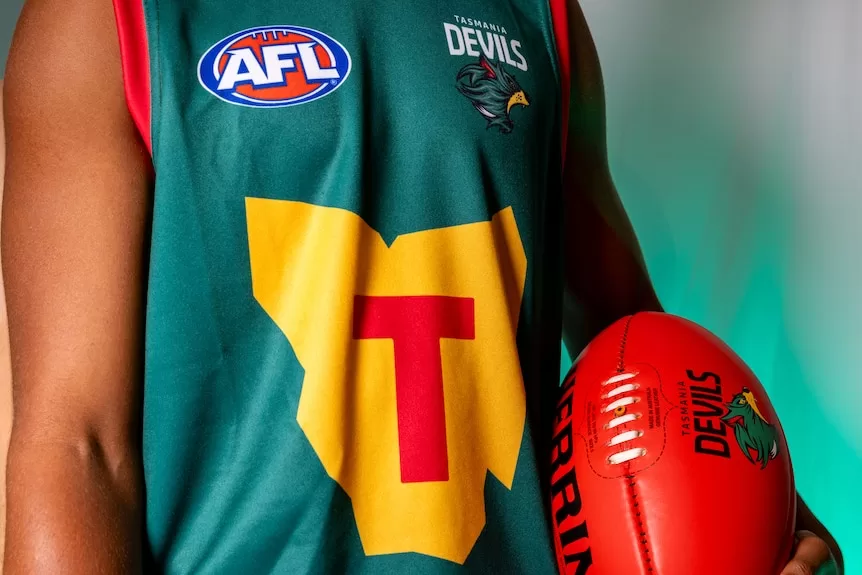Live updates, reactions and contributions from ABC readers.
Club colours will be green, yellow and red
They have unveiled the colours, name, logo and guernsey concept, with the help of junior players.
The club will be known as the Tasmania Devils, they will be green, yellow and red, the logo features a devil in profile, and the guernsey features a map with a “T”.
The colours, logo and foundation guernsey for Tasmania’s AFL and AFLW team have been released — and they each hark back to decades of tradition.
The club will be known as the Tasmania Devils, they will wear green, yellow and red, and their guernsey will feature a map of Tasmania at its centre with a red “T”.
All three elements have long been associated with football in Tasmania, and they have been formalised as the club edges closer to its long-awaited entry into the AFL in 2028.
They were announced at the club’s launch tonight, held simultaneously at six locations around the state, in addition to 20 live stream sites.
Tasmania Football Club chair Grant O’Brien said it’s an important milestone.
“Today is a special day, one we have waited a long time for — and one we will remember for a long time,” he said.
“Your club has been blown away by the community support shown at Monday night’s launch events.
“It has been a truly special moment in our state’s football history with thousands of Tasmanians joining in the cheers and tears as we, together, unveiled our club.”
The Devils nickname was always going to be preferred, provided the club could avoid long and potentially costly negotiations with Warner Bros over the right to use the name.
The colours have been associated with Tasmanian football since 1908.
The main unknown was the logo, which shows a profile of a Tasmanian devil.
Mr O’Brien said it represented Tasmania’s “proud, tough, determined” characters.
“Characters that are feisty and will fight for their survival in a uniquely Tasmanian way,” he said.
“Our Tasmanian Devil is a free spirited, powerful, and authentic identity.
“We call this Devil ‘The Wild’.”
The long road to a Tasmanian AFL team
Regardless of the politics around the team and the stadium, the launch is a historic moment for Tasmanian football.
For 30 years, bids have come and gone.
A bid involving a 30,000-seat stadium at the Hobart showgrounds was knocked back.
A 2008 bid from then-premier Paul Lennon ended in ignominy – dismissed out of hand by then-AFL head Andrew Demetriou. This was despite strong private sector backing.
And then came the entries of the Gold Coast Suns and Greater Western Sydney Giants, pushing back Tasmania’s team by decades — if not forever.
Former AFL head Gillon McLachlan appeared to entertain the idea, but a 2018 report again ruled it out.
Tasmanians took the matter into their own hands, forming an AFL task force in 2019 and gaining tripartisan political support, again arguing the commercial case for a Tasmanian team.
The stadium question reared its head — Hobart would eventually need better facilities, but opinions were divided over whether the team comes first, or a new stadium.
And in March, 2022, then-premier Peter Gutwein announced a 27,000-seat stadium at Regatta Point, contingent in the state getting a team.
He resigned, and the concept was moved to the adjoining Macquarie Point under new premier Jeremy Rockliff — following a visit to the city by AFL executives.
The stadium was formalised in writing as a condition of the team’s entry, agreed to by the AFL Commission and club presidents.
The contract was signed in May 2023, after the Commonwealth agreed to provide $240 million for the precinct.
But in Tasmania, tripartisan political support was over.
Political fight ahead over Macquarie Point stadium
There is still a lot of work to be done before the team runs out for round one, 2028.
A $70 million high performance centre on Hobart’s eastern shore should be ready, to ensure the club can attract and retain players.
And then there’s the Macquarie Point stadium.
The first season will be played at Bellerive Oval and York Park, with the Tasmanian government to pay the club $4.5 million per season if the new stadium isn’t ready by round one, 2029.
The concept of a 23,000-seat, roofed stadium on that site – a condition for the team to enter the AFL – is being assessed by the Tasmanian Planning Commission on engineering, environmental, heritage and other planning grounds.
When that work is done, likely next year, it will need to pass both houses of parliament before construction can start.
By then, updated cost estimates should be known, with the original $750 million price tag another year older. There will also be detailed plans, and final answers to two burning questions: can it actually fit on the site? And how realistic is the 2029 completion date?
In the meantime, Labor leader Rebecca White has promised to renegotiate the deal with the AFL if she ends up premier after this weekend’s election, focusing on the requirement for a stadium.
Regardless of the election result, the stadium will remain a political football.
The Liberals under Jeremy Rockliff are likely to win more seats but still be in minority, facing a progressive crossbench.
Labor’s best chance at governing would be via the Greens, or potentially a combination of independents Kristie Johnston, Sue Hickey, David O’Byrne and the Jacqui Lambie Network.
In both situations, the final stadium vote would hang by a thread.
And that’s before it gets to the upper house, where Labor and Liberals have been able to combine for a majority in recent years. That situation could come to an end, if Labor’s Josh Willie and Liberal Jane Howlett are elected to the lower house this weekend.
Their replacements in the upper house could be independents.
The club may have been launched, but the path to a stadium remains a challenge for the government, and potentially the AFL.
LoadingLoading…
